Citric Acid Cycle and Mitochondrial Electron Transport
The citric acid cycle (also known as the Krebs cycle, or tricarboxylic acid (TCA) cycle) has already been discussed in detail on steemit. The article by @simplifylife (Powerhouse of the cell, Episode 5 : Krebs cycle, The missing link!!) is particularly informative, and emphasizes the critical importance of this pathway in human biology and biochemistry. The mammalian citric acid cycle is extensively discussed in many textbooks (see for example: 'Biochemistry', by C.K. Mathews and K.E. van Holde. The Benjamin/Cummings Publishing Company, Inc. (1990); 'Biochemistry 2nd Edition', by L. Stryer. W.H. Freeman and Company. (1981); 'Biochemistry, 5th Edition', by J.M. Berg, J.L. Tymoczko and L. Stryer. W.H. Freeman and Company. (2002)). Excellent web resources are also available that discuss the mammalian pathway (and its tight coupling with mitochondrial respiratory electron transport and oxidative phosphorylation) in great detail:
but few of these resources point out some fundamental differences between the mammalian and plant pathways!
Here I would like to point out some unique features of the plant citric acid cycle, and highlight its flexibility.
As background reference material on the plant citric acid cycle I can recommend the following textbook (Jones, R.L., Buchanan, B.B., Guissem, W. Biochemistry and Molecular Biology of Plants. American Society of Plant Physiologists (2002)). I will cite additional literature as specific points of difference with the mammalian pathway are identified below.
First, let's put the citric acid cycle in context with glycolysis (discussed in my previous post) and the mitochondrial respiratory electron transport chain:
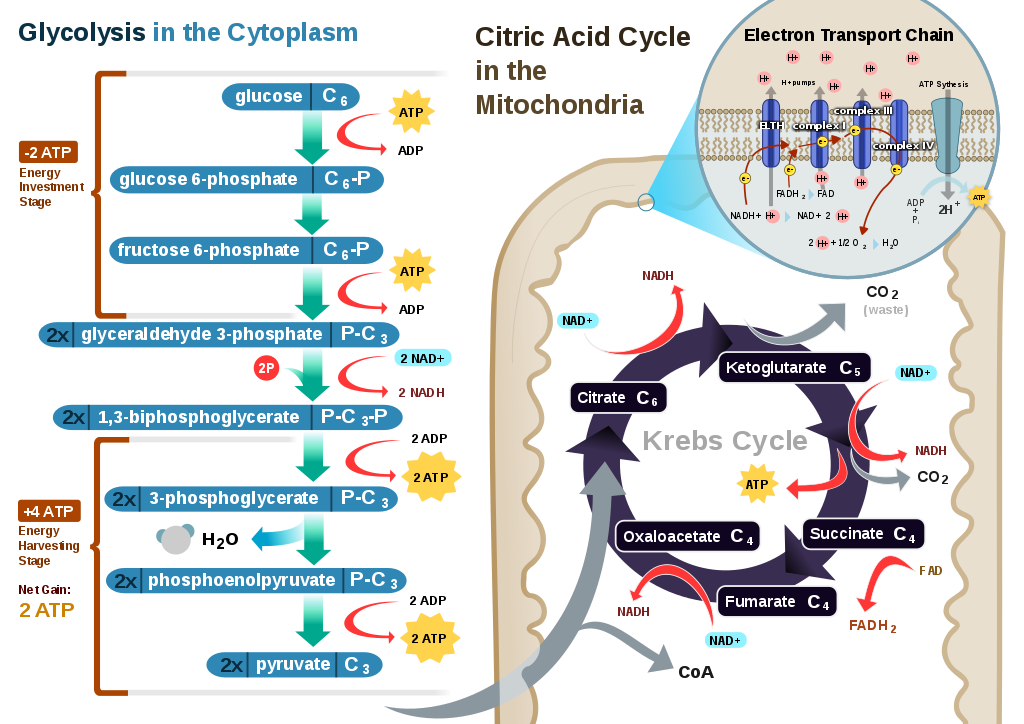
Glycolysis in the cytoplasm, citric acid cycle in the mitochondria, and mitochondrial electron transport chain. Image Source:
The citric acid cycle occurs in the mitochondion, and most components (except succinate dehydrogenase) are confined to the mitochondrial matrix:
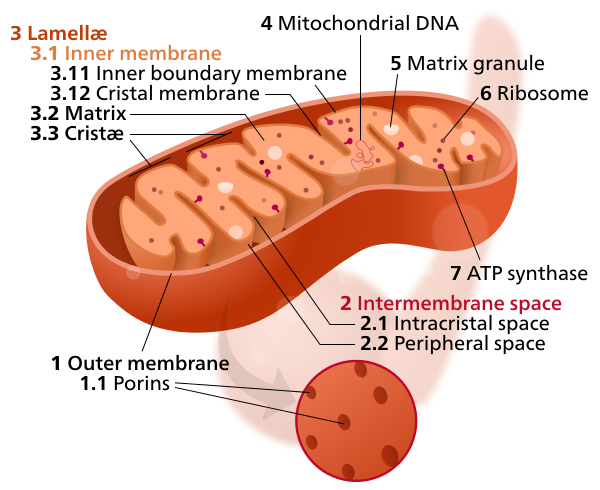
Diagram of a mitochondrion. Image Source:
Pyruvate conversion to acetyl-CoA, catalyzed by pyruvate dehydrogenase, represents the first committed step in the citric acid cycle and generates CO2 and NADH:
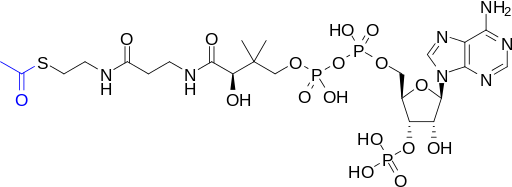
Structural diagram of acetyl-CoA: the portion in blue, on the left, is the acetyl group; the portion in black is coenzyme A. Image Source:
The acetyl moiety of acetyl-CoA (a 2-carbon unit) then combines with a 4-carbon compound, oxaloacetate, to generate citrate (a 6-C compound). Subsequent reactions catalyzed by a collection of dehydrogenases sequentially release CO2 and generate NADH, shortening the carbon chain to 5-C (alpha-ketoglutarate, or 2-oxoglutarate), to 4-C (succinate). In the diagram below, coenzyme Q (ubiquinone) is identified as the electron acceptor in the succinate dehydrogenase reaction. Strictly speaking, the succinate --> fumarate reaction catalyzed by succinate dehydrogenase reduces FAD --> FADH2 (not shown in the image below) and the latter is then used to reduce Q --> QH2. Q and QH2 are lipid soluble and are free to move within the mitochondrial membrane and assist in transferring electrons between components of the electron transport chain. Succinate dehydrogenase is the only enzyme of the citric acid cycle that is membrane bound (Succinate dehydrogenase). Oxaloacetate formed from further metabolism of fumarate (via malate) is then recombined with acetyl-CoA to repeat the cycle.
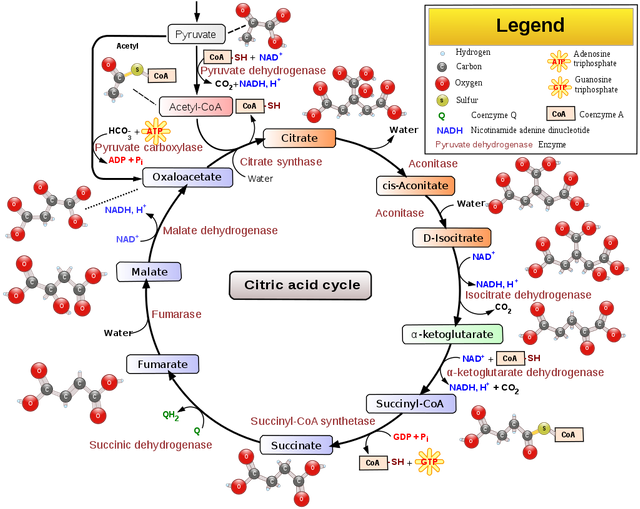
Overview of the citric acid cycle. Image Source:
When oxaloacetate or alpha-ketoglutarate (2-oxoglutarate) are removed from the cycle (e.g. in the synthesis of aspartate or glutamate, respectively), it is necessary to replenish the cycle to prevent depletion of intermediates. This replenishment is accomplished in mammals and many bacteria, by pyruvate carboxylase (an enzyme that combines pyruvate and bicarbonate (at the expense of ATP) to form oxaloacetate. Here's the first difference between animals and plants. In plants this anaplerotic synthesis of oxaloacetate to replenish the cycle is accomplished with phosphoenolpyruvate (PEP) carboxylase rather than pyruvate carboxylase:
There is debate as to whether oxaloacetate generated by PEP carboxylase in the cytoplasm is directly imported into the mitochondrion, or is first converted to malate in the cytoplasm (via malate dehydrogenase) with the resulting malate being subsequently imported into the mitochondrion to anaplerotically replenish the cycle (see the following link for a definition of Anaplerotic reactions).
We have seen in earlier articles that PEP carboxylase is an important enzyme facilitating C4 photosynthesis and CAM metabolism in plants. PEP carboxylase is not restricted to C4 and CAM plant species, but is found in C3 plants as well, and functions primarily in replenishing the citric acid cycle in C3 species. The enzyme has simply been recruited for additional purposes in C4 and CAM species!
The electron transport chain, together with succinate dehydrogenase are inner-membrane bound:
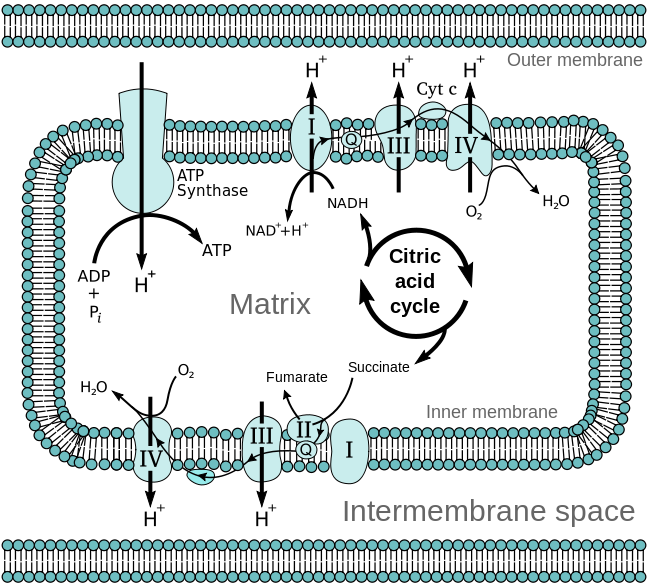
The electron transport chain in the mitochondrion is the site of oxidative phosphorylation. The NADH and succinate generated in the citric acid cycle are oxidized, releasing energy to power ATP synthase. Image Source:.
The NADH generated by the citric acid cycle dehydrogenaseas, together with FADH2 generated in the membrane-bound succinate dehydrogenase reaction participating in reduction of Q to QH2, is used to create a proton gradient between the matrix and the intermembrane space. This proton gradient is used to generate ATP by ATP synthase. Electrons are transported via several membrane-bound carriers and complexes ultimately to a terminal acceptor, oxygen, which is then reduced to water by cytochrome c oxidase (complex IV). The various mitochondrial electon transport components are described in depth by Millar et al (2011).
The mitochondrial electron transport system components somewhat resemble the reverse of those involved in the light reactions of photosynthesis (see: Light Reactions of Photosynthesis).
Plants possess an alternative oxidase (AOX) that can use QH2 to reduce O2 to water, by-passing much of the mitochondrial electron transport chain. AOX is cyanide-insensitive, unlike cytochrome c oxidase (complex IV) (Millar et al (2011)). When AOX is induced or activated in plant tissues, this generates heat (thermogenesis), as discussed in: Floral Scent - Part 6 (and a stinky end to this series!). AOX is regulated by pyruvate, citrate, NADPH and salicylic acid.
The outer membrane of the plant mitochondrion has a number of pores that facilitate free exchange of intermediates between the cytoplasm and the intermembrane space. The mitochondrion of plants is also equipped with a number of inner-membrane transport proteins that further facilitate exchange of pyruvate, phosphate, malate, citrate, 2-oxoglutarate, oxaloacetate, glutamate, aspartate, ADP, and ATP between the intermembrane space and the matrix (where the citric acid cycle enzymes are located) (these transport proteins are not shown in the images above). NADH and NAD+ are not directly transported across the inner-membrane, but their reducing equivalents can be exchanged between cytosol and mitochondrial matrix by a number of "metabolite shuttles" relying upon the afore-mentioned transport proteins (see for example: Malate-aspartate shuttle - Wikipedia).
Regulation of flux through the citric acid cycle is not well understood in plants. Nevertheless an important control point is pyruvate dehydrogenase (PDH) (the first committed step in the pathway) which can be interconverted between active and inactive forms by reversible phosphorylation. A kinase that phosphorylates and inactivates PDH is stimulated by NH4+ and inhibited by pyruvate in plants.
Plants employ the citric acid cycle in a number of ways which are outlined in detail by Sweetlove et al. (2010). Often only portions of the cycle are employed, and bypasses to the classical citric acid cycle have been identified. One variant that uses a portion of the citric acid cycle, likely employed during nitrogen assimilation (glutamate and aspartate biosynthesis) in plants, is shown below:
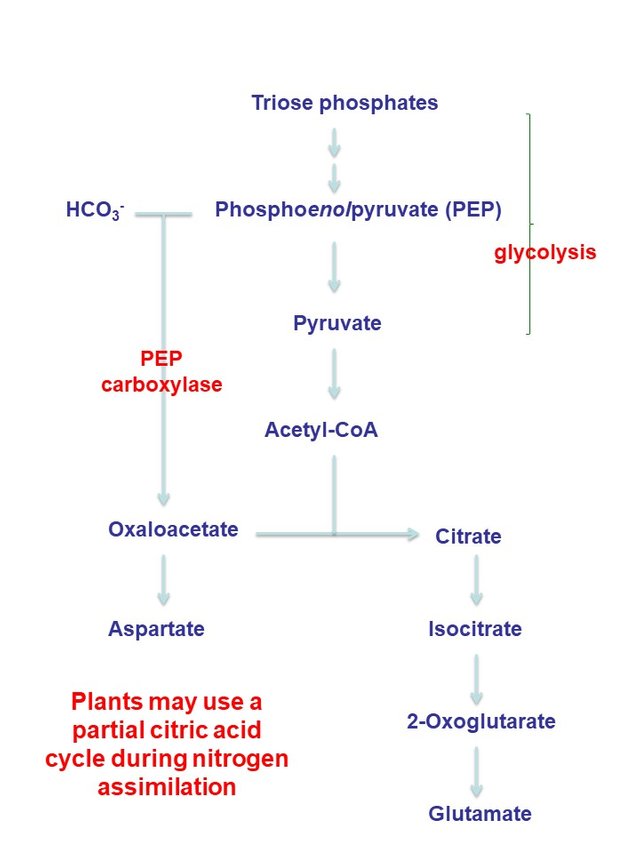
Plants may use a partial citric acid cycle during nitrogen assimilation (D. Rhodes)
An example of a bypass to the classical citric acid cycle, called "the GABA shunt", has been identified in plants, forming a circuit around the succinyl-CoA step in the pathway. In the GABA shunt (shown below), 2-oxoglutarate (alpha-ketoglutarate) is converted to glutamate, which is then decarboxylated by glutamate decarboxylase to form gamma-aminobutyrate (GABA). Glutamate decarboxylase has an acid pH optimum and is calcium/calmodulin activated in plants (Snedden et al. (1995)). During various environmental stresses (heat shock, water deficits, anaerobic stress) and in response to insect damage, GABA accumulation is stimulated as a result of cytoplasmic acidification and/or perturbations in cytoplasmic Ca2+ levels (Michaeli et al. (2011), Michaeli and Fromm (2015)).
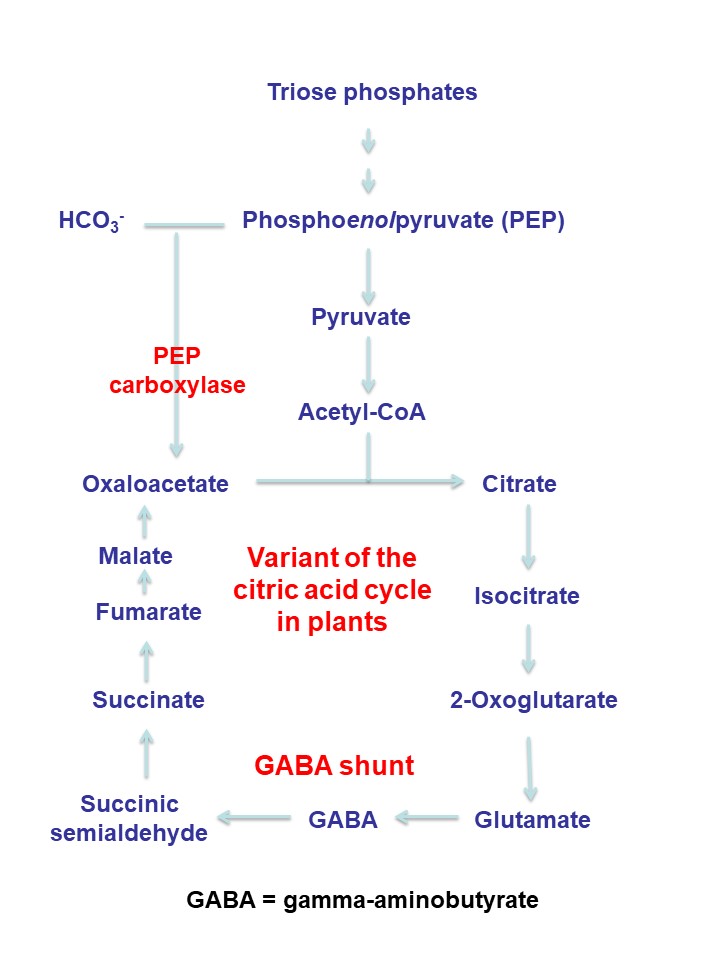
A variant of the citric acid cycle in plants: the GABA shunt (D. Rhodes)
GABA can be transaminated to either alanine or glutamate, to form succinic semialdehyde, which can then be converted to succinate and re-enter the citric acid cycle.
These two examples, briefly outlined above, are only a small fraction of the enormous number of variations in flux modes of the citric acid cycle used by various plant species and organs during different stages of development and in response to specific environmental conditions. I encourage readers to consult Sweetlove et al. (2010) for a more detailed discussion of this flexibility/plasticity of the plant citric acid cycle .... the pathway is often not just a circle!
Finally, I can recommend the article by Cavalcanti et al. (2014) cited below, for a thorough review of the evolution of the citric acid (TCA) cycle, including phylogenetic analyses of gene sequences of the key enzymes of the pathway in different organisms including numerous plants, animals and humans.
Please feel free to add comments or ask questions below. I will attempt to answer as soon as possible.
References
Thank you, this post was very informative, this time your images have no issues :)
Cellular Respiration Part 2: The Kreb's Cycle
Craig Savage
Published on Jan 18, 2012
Continued details on cellular respiration with a focus on the Kreb's cycle.
Electron Transport Phosphorylation
Craig Savage
Published on Jan 18, 2012
Cellular Respiration Part 3: The Krebs Cycle - Detail on Cellular respiration. This video describes the process of chemiosmosis during aerobic respiration.
Your Post Has Been Featured on @Resteemable!
Feature any Steemit post using resteemit.com!
How It Works:
1. Take Any Steemit URL
2. Erase
https://3. Type
reGet Featured Instantly & Featured Posts are voted every 2.4hrs
Join the Curation Team Here | Vote Resteemable for Witness